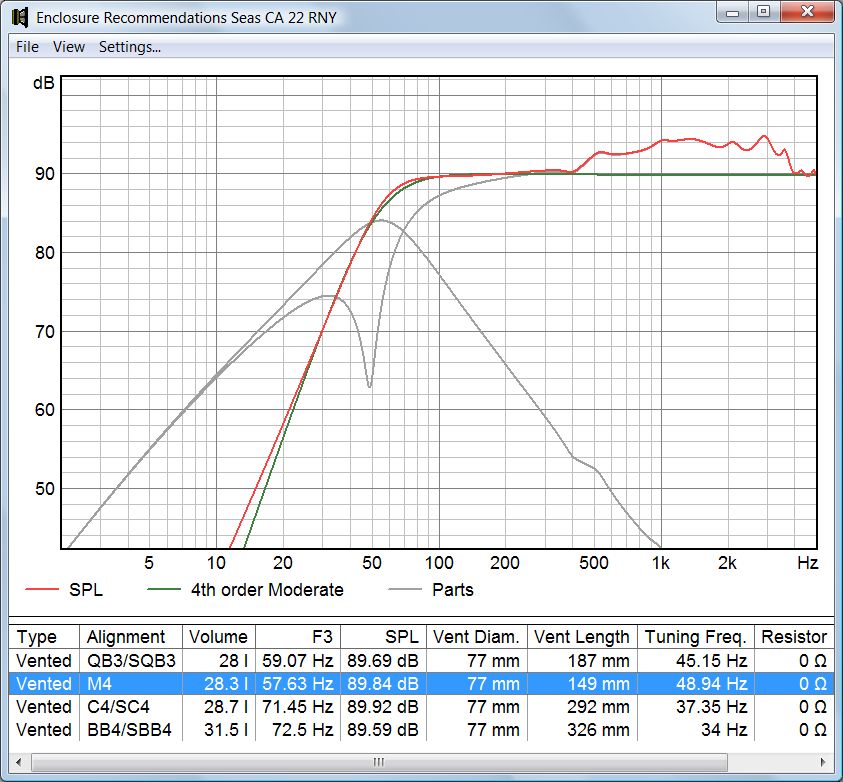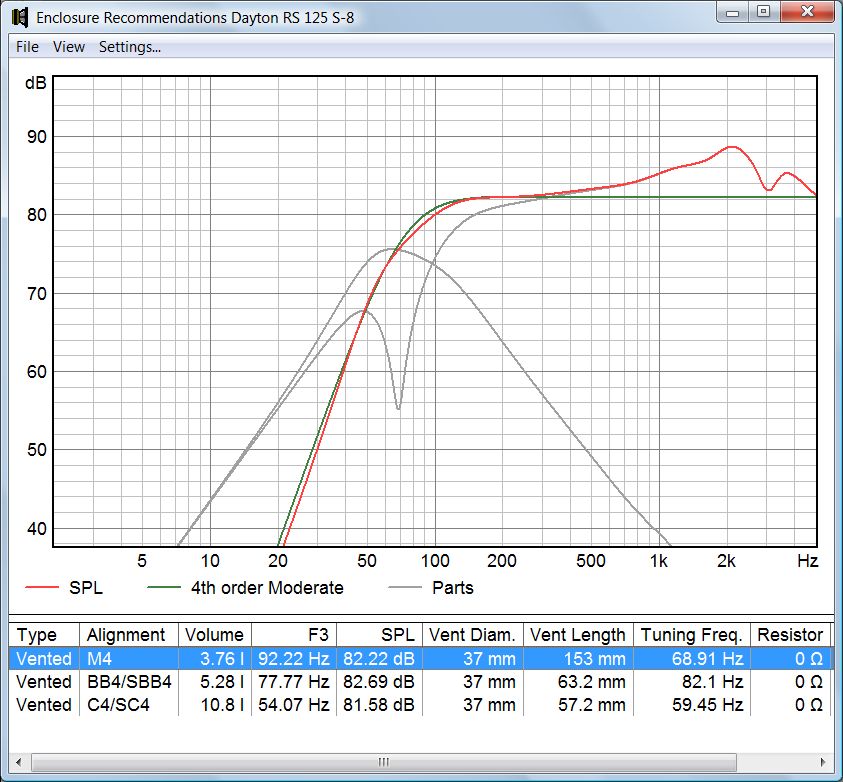
| Fourth order Moderate - A new alignment for vented loudspeakers. Revision 1 |
|
During my work on the MZ SpeakerDesigner, a loudspeaker design and simulation
program, I was confronted with the topic of alignment of vented loudspeakers.
The first approach was to implement the alignment tables given in Vance
Dickason's book. As the results of the simulation were quite ambivalent,
I decided to solve the problem my way and programmed an approximation
procedure, which alters the volume and the tuning frequency of a box until
the best match with a desired target function is achieved. MZ SpeakerDesigner is now capable to solve this problem for eight different target functions in the range from third order Bessel (high cutoff frequency, best transient response) up to a crazy filter I called fourth order Extreme (low cutoff frequency, terrible transient response). Somewhere between the excesses there must be an optimum, a balanced solution having a decent bass performance and transient response. I came to the conclusion, that this alignments lies exactly between fourth order Bessel and fourth order Butterworth. Therefore I created a new target filter and called it Moderate. |
|
Having hundreds of different drivers in my database, it was interesting
to watch the results of the approximation procedure. Although there are
small and large drivers, light and heavy diaphragms, weak and strong
magnets, the results showed astonishingly little variations. Only drivers
having a large voice coil inductance have not been considered, as their
transfer function does not really match the target function. After plotting
the results of the fourth order Moderate approximation, it was easy to
express the volume and the tuning frequency as a simple function of Qts,
Vas and Fs. The equations presented below are not founded on any theoretical derivations, but solely the result of a computer optimization and practical engineering. The simulation of MZ SpeakerDesigner is based on the driver model currently used in science, extended by a lossy inductance model and an edge diffraction algorithm. Further considered is the time the backsided sound needs to travel through volume and vent. The front opening of the vent is assumed to be identical to the center of the driver. The average baffle width is the driver's diameter plus 6 cm, the quality of the helmholtz resonator is 7 and the microphone distance is one meter. It turned out that the influence of baffle edge diffraction is significant and must not be neglected. Particularly affected is the tuning frequency. Therefore different equations for an average baffle and the infinite baffle were compiled. In the examples below the drivers are mounted in the average baffle. While simple theory generally predicts a fourth order roll-off for vented loudspeakers, the simulation shows a third order roll-off for drivers having a low Q and a fourth order roll-off only at high Qs. |
|
M4 alignment for average baffle: Volume = (2.68 * Qts - 0.45) * Vas Tuning frequency = 0.41 * sqrt(1/(Qts*Qts) + 0.97) * Fs M4 alignment for infinite baffle or car application: Volume = (2.52 * Qts - 0.35) * Vas Tuning frequency = 0.32 * sqrt(1/(Qts*Qts) + 3.38) * Fs |

| QB3/SQB3 | M4 | C4/SC4 | BB4/SBB4 | ||||||
| At Qts 0.25 the M4 alignment requires nearly the same volume as QB3/SQB3. The higher tuning frequency yields the lowest cutoff frequency (F3) of all alignments. QB3/SQB3 results in a third order Butterworth transfer function, which has a slightly better transient response than M4. C4/SC4 and BB4/SBB4 do not work at all at such a low Q and give a poor bass performance and very long vents. |

| QB3/SQB3 | M4 | C4/SC4 | BB4/SBB4 | ||||||
| All alignments result in almost the same volume for Qts of 0.3, only BB4/SBB4 is little larger. QB3/SQB3 has changed the transfer characteristics to fourth order Moderate. C4/SC4 and BB4/SBB4 are now close to third order Bessel. |

| M4 | BB4/SBB4 | C4/SC4 | QB3/SQB3 | ||||||
| A Qts of 0.35 is ideally suited for vented loudspeakers. All known alignments give almost the same volume, only M4 is smaller. Different tuning frequencies result in transfer functions between fourth order Bessel and fourth order Moderate. |

| M4 | BB4/SBB4 | C4/SC4 | QB3/SQB3 | ||||||
| At Qts 0.4 BB4/SBB4 results in a fourth order Moderate transfer function and is close to M4, which has a smaller volume and a higher tuning frequency. C4/SC4 and QB3/SQB3 already show a fourth order Butterworth behaviour. |

| M4 | BB4/SBB4 | C4/SC4 | QB3/SQB3 | ||||||
| BB4/SBB4 is now steeper than M4 and reaches a fourth order Butterworth frequency response. C4/SC4 and QB3/SQB3 use a significant larger volume and show an extended flat or extreme transfer function. Regarding the transient response, these two alignments are already rather questionable (very boom boom). On the internet I read the story of a poor guy who tried a QB3/SQB3 alignment for a driver having a Qts of 0.43. He was very disappointed and had to rebuild the speaker using a BB4/SBB4 alignment... |

| M4 | BB4/SBB4 | C4/SC4 | QB3/SQB3 | ||||||
| At Qts 0.5 BB4/SBB4 exceeds the flat response and starts to peak, while M4 still stays moderate. C4/SC4 and QB3/SQB3 are extreme. |

| M4 | BB4/SBB4 | C4/SC4 | ||||
| A Qts of 0.55 is the upper limit used for vented loudspeakers. The M4 alignment is still on track, while BB4/SBB4 gets worse. |
|
It has been shown, that all known alignments work only in a limited
range of Qts and produce strongly case dependent transfer functions.
The simulation fully confirms the simple old rule of experienced speaker
builders: Use QB3/SQB3 for Qts below 0.37 and BB4/SBB4 above. A new alignment has been proposed. The M4 alignment is easy to calculate as it is defined by two simple equations instead of an alignment table. The new alignment shows a nearly constant transfer function in the entire range of Qts used in vented loudspeaker design. The target transfer function lies exactly between fourth order Bessel and fourth order Butterworth and is called Moderate. For Qts below 0.35 the M4 alignment is the only alternative to QB3/SQB3 and provides a lower cutoff frequency. For Qts above 0.4 the M4 alignment is the only alternative to BB4/SBB4 and gives a better transient response in a smaller volume. Characteristic for the M4 alignment is a well dosed vent. The spl of the vent is typically 6 dB below the nominal driver spl. Hence the tuning frequency of the M4 alignment is close to the -6 dB cutoff frequency of the total transfer function. |
| About the author |
| MZ SpeakerDesigner |
| Contact (Email) |
Last update: 10 December 2012